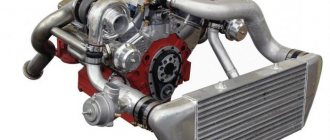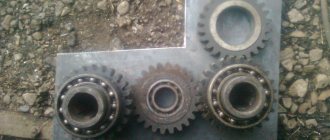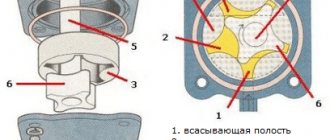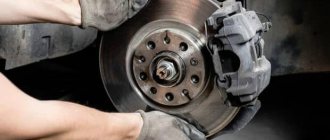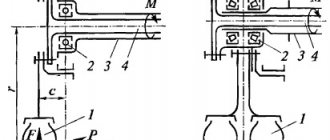Restart › Blog › Increased consumption and presence of oil in the intercooler. Is the turbine always the cause?
Hi all.
We decided to start our blog with an analysis of probably the most common problem from our practice - increased oil consumption and its presence in the intercooler, pipes and turbine. Basically, this problem is interpreted on Internet resources as a consequence of the malfunction of the turbocharger, they say that it is “tired”, the mileage is already more than 100 thousand, it’s time to “shake up” the turbine. Often, such a quick decision to repair the turbine ultimately leads to nothing - the oil has left the engine and continues to leave. Of course, the turbine workers are to blame - they did not repair it well. In fact, the repair organization is indeed at fault, but rather not in poor-quality repairs, but in the fact that they did not bother to completely understand the situation, “cured a healthy person,” but the real problem remained unresolved.
Besides a broken turbine, what could cause oil leakage? The essence of the problem is that excess gas pressure forms in the crankcase. Firstly, it creates the effect as if the turbine drain pipe was plugged with a plug. Accordingly, the oil, which is supplied to the turbine under pressure, simply begins to “pinch” into all the cracks - both towards the intercooler along with the forced air, and towards the muffler. Secondly, abundant oil vapor from the crankcase enters the turbine suction through the breather, passes through it and again enters the intercooler.
What could be the cause of increased gas pressure in the crankcase? — breakthrough of gases from the combustion chamber into the crankcase due to stuck piston rings or through loose injectors (if we are talking about a diesel engine where the “body” of the injector is located under the valve cover) — incorrect operation of the crankcase ventilation valve — clogged catalyst / particulate filter. Accompanied by some drop in dynamics. By the way, during chip tuning there may be no errors if the catalyst or soot is clogged.
Surprisingly, more than 90% of customers who contact us consistently check the presence of oil in the discharge pipe and in the intercooler, i.e. at the outlet of the turbine, but almost no one attaches importance to the condition of the pipe at the inlet to the turbine from the air filter. But this is where the breather is embedded, and the presence of oil in the pipe at the turbine inlet is a direct indicator of engine malfunction. Also, the fact of exhaust breakthrough into the crankcase can be detected by the condition of the compressor (air impeller) - the presence of soot on the blades. The most pronounced consequence of gas breakthrough from the piston is the presence of oil coke on the back side of the impeller. This is a direct indication that gases from the crankcase were rushing into the turbine through the drain pipe, naturally preventing the oil from draining.
I note that all of the above does not exclude the presence of a turbine malfunction. The best thing to do in such a situation is to at least check the condition of the turbocharger parts. The main thing is not to limit yourself to one thing, the problem needs to be solved comprehensively!
Our page on DRIVE2:
Comments 161
The key word, as we understand it, is “suspect”...
Then let me ask you a few questions: — order number? — or the (approximate) date of repair and the last 4 digits of the phone number that was left when placing the order? - year of the car? — engine size or turbine number? — oil consumption (approximate) per 1000 km after turbine repair? That's all for now. We will be happy to sort out the situation.
2017 is all I remember A3 2005 consumption before repair was 2.5 liters from replacement to replacement after repair liter per thousand. Volume 2.0. Your showdowns won’t make things any easier for me. The impeller is covered in oil, there are obvious leaks. The car has been sold for a long time. Maybe, of course, your employees have changed and are now doing well.
Is the impeller on the hot or cold side?
I didn't see this as a problem with this car when it was hot, but when it was cold
.Q.E.D!
Next is elementary physics: Oil from the turbine bearing housing can enter the cold scroll only along the shaft (on which the compressor impeller is mounted), i.e. from its center. Further along the reverse side of the impeller, under the action of centrifugal force, it moves to the edge of the impeller, and then breaks off and is carried away by the flow of forced air into the inlet. This oil will not move back to the center (the laws of physics do not allow it), so it will not be able to get onto the impeller blades. And the oil that you saw on the blades can only come from the breather, i.e. from the VKG system. So your dislike is in the wrong place.
The VKG valve has been changed and the system has been checked. I have visited you more than once. You, citing that you do not have such equipment, said that I should check, I went to the services and checked
Don't have any equipment?
If you decide to educate people about our incompetence, then give some compelling argument. For example, how did they even check your VCG in another service? What were the experts based on? what numbers? Exactly the numbers! The “blow, spit and decide” option is not an option. “It doesn’t matter” and “I don’t remember” are not serious. If you don’t remember, remember.
And whose “writing,” as you deigned to put it, paints whom and how—let the people decide.
Good evening. I can get answers/advice on this problem from you. Auto...Fiat, Fullback, aka L200 5. Engine 4N15. Mileage 120,000, oil changes every 6-7 thousand. Filters accordingly, well, plus depending on the situation. Operation: 90% highway. There is Webasta. In the summer, at 100 thousand, I noticed “normal” traces of oil on the flanges of the pipes to and from the cooler. I washed it and there was a very light coating of oil. Kind of the norm. Now, the oiling is very strong, all flanges are pressing oil. The pipe in front of the valve has a good layer of oil inside. I checked the PCV valve today. It blows in both directions. Died. (The thing is, in my previous car, 4V12 engine, I ate a small dog))) with this valve. 70 thousand was a glutton of oil. They prophesied capital. I didn't believe it. As a result, I replaced this valve, the zhor went away, the engine went another 120 thousand and was sold in excellent condition). What I mean is that I went to look at this valve here too. The situation differs only in the presence of a turbine. But... 1. At idle, gases come out of the PCV hose. 2. Covering with your finger immediately creates pressure in the crankcase. A lightly pressed finger pushes away. 2. The same hose and the entrance to the air supply pipe are covered in oil. Those. It’s perfectly clear where the oil comes from. I think the impeller is all covered in oil. I took a video. I don’t see how to attach it. It seems to me that the flow of crankcase gases for idle speed is too strong. But... the engine works great, pulls great. The problem is that the Japanese made the PCV valve not removable. It cannot be unscrewed and the valve is closed. Well, or somehow it’s removed from inside the CC, which is also tough. Therefore, it has not been possible to replace the valve easily yet. Yes, and I’ve now gone to the Krasnod region for New Year’s. I'm thinking of putting a valve in the cut in the hose, but I haven't found one here today. What do you think about this situation? I know that the valve is closed at XX, only small gaps remain. But I have such a flow of gases that a closed valve cannot cope. Or is this the norm for a diesel engine? Well, with such an escape, with such maintenance, it’s impossible to lay down the rings and everything else that lets exhaust gases into the crankcase in such large quantities? I bought an oil trap back in the summer (a well-known centrifugal one from the Koreans with a membrane on top), but never installed it, due to this virus. Which I regret now. I feel like I'm missing something. Or is it still capital? Thank you.
What is an intercooler for?
The cooler is a kind of radiator. The purpose of the device is to cool the compressed air before supplying it to the cylinders of the internal combustion engine. Cooling allows more air to be placed into the cylinder, resulting in more fuel being burned. The engine power when supplying cold air under pressure is much higher. The location for installing the intercooler is naturally the area after the turbine. The use of a cooler on a diesel engine made it possible to achieve an increase in power, reduce the toxicity of exhaust gases, obtain complete combustion of the fuel-air mixture, and reduce fuel consumption. The turbocharged diesel engine has become more revving, the low-end torque characteristics and engine efficiency have increased, and the maximum speed of diesel engines has become higher.
The installation of an intercooler on a diesel engine is due to the fact that engines of this type are extremely demanding on the temperature of the working mixture compared to gasoline internal combustion engines. The cooler is capable of reducing the charge air temperature to 55-70 degrees Celsius.
Air cooling in the system can occur according to the following schemes:
- air cooling;
- liquid cooling;
- combined scheme;
- In the first case, air is pumped by a turbocharger and then passes through the intercooler honeycombs, releasing excess heat into the atmosphere. This diagram resembles the operation of a radiator in an engine cooling system.
- Cooling according to the second scheme involves passing air through a device filled with cooling liquid. Such a solution is structurally more complex and more expensive, since it requires the installation of an additional pump for pumping liquid, as well as separate electronic control units.
- Combined cooling is used in turbocharging designs on high-performance racing cars. The charge air cooling circuit in such machines includes several intercoolers, some of which operate on the principle of air cooling, while others are variants of liquid radiators. Coolers in combined circuits are used in series.
We also recommend reading the article on how to properly cool a turbine after intense driving. From this article you will learn about the operating conditions of a diesel engine turbocharger and operating features to extend the life of the supercharger.
Cooling based on the air-to-air principle is less efficient compared to air-to-water circuits and combined solutions. At the same time, the main advantage of an air radiator is the simplicity and availability of this solution, which led to the widespread installation of intercoolers of this type on serial diesel and gasoline cars.
Why does the turbine drive oil into the intercooler?
Engine oil is needed to reduce friction between the working surfaces of the turbocharger. In its absence, the elements would fail after a very short period of time. To produce working fluid, the turbine is connected to the engine. Experienced drivers advise changing the oil as often as possible.
Oil in the intercooler pipe is evidence of a turbocharging malfunction. The node must be examined immediately. Of course, it is possible to repair the turbine, but it will not cost less than a complete replacement. Therefore, it is worth taking preventive measures to prevent malfunctions.
What is an intercooler
It is well known that compressed air burns more fuel and results in a significant increase in engine power without increasing the physical volume of the cylinders. This solution is widely used in almost all modern diesel engines, as well as in the design of forced gasoline units.
An intercooler is an element included in the overall design of a turbocharger. The fact is that the air is strongly compressed by the turbocharger and, as a result, heats up. If heated air is immediately supplied to the cylinders, its volume will not be enough for efficient and complete combustion of the fuel part. Engine power decreases and fuel consumption increases noticeably.
Oil in the intercooler of a diesel engine: reasons
There are several reasons why this problem occurs. Let's look at each one.
Malfunctions in the crankcase ventilation system
When a car drives off-road, when it accelerates and its engine runs unevenly, high pressure arises during fuel combustion. It is much greater than what occurs under normal conditions. A large amount of gases enters the engine sump. If the sump ventilation system works correctly, gases can freely pass into the intercooler, and then into the combustion chambers along with the fuel. The oil catcher and valve springs wear out over time. This leads to an increase in pressure in the pan, which in turn causes the injection of working fluid into the intercooler.
Oil filter problems
If the oil filter becomes clogged, fluid circulation is impaired, causing pressure to rise. This leads to damage to the seals of the propulsion system. A leak appears and the supercharger blades throw oil into the cooler. After changing the filter, the leak will, of course, decrease, but will not disappear at all. This problem can be completely solved by replacing the seals.
Air filter
When the intake valves open, the connecting rod moves down, and a large vacuum is created in the pipe connected to the pan ventilation. When the filter is clogged, gases escape more strongly, which occurs due to different pressures in the pan and the pipe. When they break out, they take oil particles with them. At the same time, the oil catcher works worse and worse, which causes the appearance of working fluid in the cooler.
Also, a lack of air mass worsens the quality of the fuel. The air-fuel mixture becomes excessively rich, and the lubricant entering the combustion chambers further changes the air-to-fuel ratio.
Motor overheating
If the engine runs for a long time at high speeds, this will certainly cause the coolant to boil. If this happens, lubricant vapors will also be added to the gases penetrating from the combustion chamber, which simply cannot help but appear at elevated temperatures. There will definitely be a vapor plug in the engine head if the coolant starts to boil. The cylinder head temperature will increase, which will increase oil evaporation. Hot lubricant loses viscosity, becomes more fluid, and can penetrate even minor cracks in the oil seals. Therefore, the impeller begins to pump air containing oil particles.
Non-working turbine
The turbine can operate normally for 150,000 km. But this is only possible when using a good lubricant and maintaining optimal pressure. Oil will certainly appear in the intercooler if the pressure increases and the technical characteristics of the working fluid change. For some time, the role of an oil fluid catcher will be played by the radiator, blocking the path of particles into the combustion chamber. When the lubricant level reaches the lower cells, a carburation effect will occur and oil particles will be drawn into the air. Fuel parameters will change.
Turbine oil line
The oil hose must carry the working fluid freely. If it is bent, the passage of lubricant will be difficult. As a result, the turbine, if there is a leak through the seals, will drive air with elements of oil fluid into the cylinders.
Why can a heat exchanger break down?
Like any other mechanical component of a car, the intercooler can be susceptible to various types of malfunctions during operation.
Most often they arise due to untimely replacement of consumables and lack of an adequate level of maintenance of all related components and elements.
One of the main problems with the intercooler is related to the violation of its tightness. Simply put, he simply vomits. This problem can be caused by a number of reasons.
- One of them is mechanical damage due to foreign objects entering through the radiator grille.
- The second has a different origin. Often, heat exchanger elements fail due to high pressure in the system.
Underwater pipes also cause headaches for turbodiesel owners. It happens that during long-term use or simply due to their poor quality, they burst or lose elasticity.
It is important to remember that in this case you need to use only special connecting and sealing elements designed for the specified parameters. This will allow you to achieve uninterrupted operation of your car and save you from unnecessary expenses.
Source
Consequences: is the oil in the intercooler dangerous?
The intercooler of an internal combustion engine whose mileage is more than 100,000 km contains at least 40 grams of lubricant. If the working fluid is below the level of the internal cells, this is not dangerous for the operation of the propulsion system. But if the radiator is filled with lubricant to the lower cells, it is actively drawn into the combustion chambers along with the air mass. This causes poor quality fuel burnout. Detonation appears in the cylinder head and exhaust pipes. The consequences can be serious - the valves will burn out and the same thing will happen to the exhaust manifold.
Checking the intercooler for leaks, how and with what to seal it
In fact, the intercooler is not the most familiar part in a car for domestic motorists. After all, this unit is usually used, designed to cool the air used to use the combustible mixture for internal combustion engines on turbocharged engines. Which the domestic industry simply did not produce en masse. Another thing is the leaders of the global automobile industry, for whom the presence of turbocharging is like a sign of the noble origin of the model. Well, if there is a turbine on the engine, that means there is an intercooler designed to cool air passing under high pressure (that’s the idea of a turbine).
Malfunctions
Mechanical breakdowns
Main problem
– mechanical integrity of cooling fins. Since it is located in front of the main radiator, it is the first to encounter all road debris. A stone can get into it, damaging the thin plates. This reduces the heat exchange area, and accordingly the intercooler efficiency decreases. The air pressure from the turbine will decrease if the seal is broken.
Dirt from the road
, sticking to the honeycomb, also reduces heat transfer. The air will not cool to the required temperature, and the engine will lose power. The above applies to air-to-air intercoolers. Liquid options are not susceptible to mechanical damage.
Metal corrosion
. This is also possible, but less often. Rusting tubes begin to leak hot air or coolant. In the second case, wet spots under the car are typical.
The inlet and outlet pipes are susceptible to damage. They can dry out if they are rubber, or rot if they are made of metal. Except
Intercooler oil
If there is a lot of it there, this is a “bell” that the turbine needs to be diagnosed. It compresses the air and it is sent to the radiator for cooling. If we find traces of oil in it, it means the turbo unit has “drove” oil. This is a sign of imminent repairs.
If you miss this moment, then in addition to expensive repairs of the turbine, you will have to clean the throttle and all the elements that are located after it, as they will become “overgrown” with oily carbon deposits. In addition, the oil in the intercooler impairs the heat exchange between the compressed air and the radiator surface. As a result, worse cooling and less power.
Appearance and location in the car
The cooling radiator and intercooler have similar designs and are very similar in appearance. The device has cooling surfaces in the form of plates welded to tubes, as well as pipes for connection to other components. The plates are usually made of non-ferrous metal.
In the air supply circuit, this mechanism is located behind the inlet manifold in front of the engine turbine compressor. Typically the device is mounted in front of the main radiator. But there are vehicles in which the intercooler is installed above the engine or to the side of it in the front fenders.
Types of designs
Currently, the intercooler is used everywhere, on various types of cars. It can be found on both gasoline and diesel cars.
The first and most common type of intercooler is an air-type heat exchanger. It is a kind of battery consisting of tubes connected by plates. Both of them perform the function of heat-removing elements.
On average, this type of intercooler ensures that the air mixture passing through it is cooled to 45-50 degrees. Its presence allows you to increase engine power by 15-20%. The greatest positive effect from the operation of the heat exchanger can be seen when driving at a speed of at least 40 km/h.
Despite all the advantages of the presented device, it also has one rather significant drawback. Due to its functional features, the air-to-air intercooler is very bulky.
In factory conditions, this problem can be solved without much difficulty. It is much more difficult to install this device; there is a need to equip your car with a turbocharger in a garage environment. In this case, there is often a need to make changes to the design of the car body, which entails a lot of inconvenience.
Related article: Thermostat - operating principle, testing and troubleshooting
The next type of heat exchanger is usually called water . The working medium in this case is water or refrigerant. Externally, this type of intercooler is strikingly different from the previously presented type.
- Firstly, it is more compact than its air counterpart. It is worth noting that water, unlike air, has a much greater heat capacity. This explains the good heat transfer of this device.
- The second, no less significant advantage is high efficiency.
A comparative analysis of the two systems showed that the water heat exchanger is many times superior to the air heat exchanger in terms of basic performance indicators.
A water intercooler is good for everyone, but it still has one drawback. It lies in the design features of the device. The fact is that to ensure full operation of the intercooler, it is equipped with a temperature sensor, a control unit and a water pump. Each of the presented system components requires systematic diagnostics and timely maintenance.
In addition, if one of these components breaks down, the car owner will be forced to pay quite a lot of money. That is why, in order to reduce the cost, an air analogue of this device is installed on most budget cars.
How to operate a car with an intercooler
A diesel engine, the design of which is characterized by the presence of a turbocharger with an intercooler, requires certain skills and abilities from the driver.
Among other things, when operating such motors, you should adhere to some rules:
- First of all, you need to take into account the fact that all turbodiesels are extremely sensitive to the quality of oil and fuel. It is very important to use only those fuels and lubricants that are recommended by the manufacturer;
- You should not operate the car idling for a long time. At low engine speeds, its complete cooling will not be ensured, which will negatively affect the wear resistance of its components;
- Do not panic when you see oil particles on the surface of the air filter. This phenomenon does not at all mean that the turbine requires replacement, as many “experts” claim;
- At the end of each trip, you should leave the engine idling for a while, no more than 1-2 minutes;
- During operation, you should not use the engine at what is called half-strength. From time to time he needs a kind of “shake-up”, of course, within reason.
Features of operation and main causes of failure
Modern intercooler models do not require special care for a long time. However, periodic inspection and timely diagnosis of failure are necessary. The following damage may be found in the part:
- Rupture of a pipe or heat exchanger due to excessive pressure. This breakdown is indicated by a sharp drop in the car’s power and increased fuel consumption. There is no point in repairing broken pipes, since under air pressure they will immediately fail again. In this case, only replacing the pipe will help restore functionality.
- Oil getting into the interior. Normally, a small amount of oil enters the intercooler during turbine operation. Acceptable values are 0.7-1 liter per 10,000 km. If the indicators are higher, you should think about repairing the part.
- Cracks in tubes and plates. An intercooler installed in the fenders or under the front bumper is subject to increased mechanical stress.
- Clogged tubes. This happens especially intensively in winter. Therefore, in winter, it is necessary to clean the part from chemicals and sand as often as possible.
